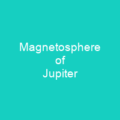Jupiter: The Giant of Our Solar System
Imagine a planet so massive that its mass is over 2.5 times that of all other planets combined—this is Jupiter, the fifth planet from our Sun and the largest in our solar system. How can such a behemoth exist, and what makes it so unique?
The Atmosphere: A Mixture of Hydrogen and Helium
Jupiter’s atmosphere is primarily composed of 76% hydrogen and 24% helium by mass. 
The Magnetic Field: A Titan Among Planets
But Jupiter isn’t just about its atmosphere; it also boasts the strongest magnetic field in our solar system. This magnetic field is generated by eddy currents within its fluid metallic hydrogen core, making it a true giant among planets.
The Moons and Rings: A Dance of Celestial Bodies
With at least 95 moons orbiting around it, Jupiter is like a cosmic dance floor. The four largest moons—Io, Europa, Ganymede, and Callisto—are known as the Galilean moons, named after their discoverer, Galileo Galilei.
The Rings: A Faint but Fascinating Feature
And then there are Jupiter’s rings. These faint structures consist mainly of dust and appear to have three main segments: an inner torus, a relatively bright main ring, and an outer gossamer ring. They’re like the delicate brushstrokes of a cosmic artist.
The Formation and Migration of Jupiter
Now, let’s dive into how Jupiter came to be. Scientists believe it formed about one million years after the Sun, roughly 50 million years before Earth. Was Jupiter always where we see it today? Not exactly; its migration from the inner solar system eventually allowed the inner planets—like Earth—to form.
Theories and Models: A Journey Through Time
Models like the Nice model suggest that Jupiter’s migration caused Saturn to shift into a higher orbit, disrupting the orbits of Uranus and Neptune. This led to the Late Heavy Bombardment, which reshaped the inner solar system as we know it today.
The Atmosphere: A Symphony of Colors and Storms
But Jupiter’s atmosphere is not just a simple mix of gases; it’s a symphony of colors and storms. The Great Red Spot, an anticyclonic storm larger than Earth, has been raging for centuries. What causes this persistent storm? Scientists are still trying to unravel the mystery.
The Interior: A Mixture of Elements
The interior of Jupiter is a mixture of hydrogen and helium, with trace elements like carbon and oxygen. The planet’s rapid rotation gives it an oblate spheroid shape, with a noticeable bulge around the equator.
Observation: A Long History of Discovery
The observation of Jupiter dates back to ancient times when Babylonian astronomers first noticed its movements. How has our understanding of this giant planet evolved over time? From Galileo’s telescopic discoveries in the 17th century to modern missions like Juno, each mission brings us closer to uncovering Jupiter’s secrets.
The Missions: A Journey Through Time
Missions like Pioneer 10 and Voyager have provided invaluable data about Jupiter. The Juno mission, which arrived in 2016, has been studying the planet from a polar orbit, sending back stunning images of its north pole.
The Future: Exploring Further
With missions like EJSM/Laplace and Jupiter Icy Moon Explorer (JUICE) on the horizon, we’re poised to uncover even more about this giant planet. What will future discoveries reveal? Only time—and exploration—will tell.
The Legacy of Jupiter
Jupiter is not just a planet; it’s a symbol of the vastness and complexity of our universe. From its massive size to its intricate atmosphere, from its numerous moons to its faint rings, Jupiter continues to captivate us with its mysteries.
So, as we gaze at this giant in the night sky, let us remember that every discovery brings us closer to understanding not just Jupiter, but the very fabric of our cosmos. What will you discover next?
You want to know more about Jupiter?
This page is based on the article Jupiter published in Wikipedia (retrieved on December 8, 2024) and was automatically summarized using artificial intelligence.







